

Steep cliffs surround the hot, brown valley that holds Khirbat en-Nahas, one of the largest copper mining and smelting sites of the ancient world. The desolate valley in Jordan is not the cradle you would expect to nurture a civilization, but archeologists Stephen Savage and Tom Levy think it may be the site of an early organized state.
“Copper mining and smelting is a hallmark of early state-level society in the eastern Mediterranean,” says Savage, a researcher from Arizona State University. His team is uncovering evidence for sophisticated economic and political activity in the valley about 3,000 years ago.
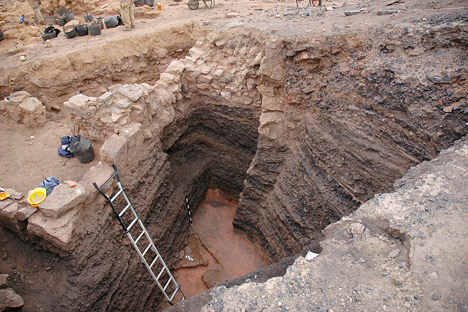
A slag mound at Khirbat en-Nahas provides evidence for organized, large-scale copper mining and smelting in the Jordanian desert about 3,000 years ago. The copper slag is piled in black layers under a building some 100 years newer than the heap. (Photograph ©2008 Thomas Levy, UC San Diego.)
Savage has never been to Khirbat en-Nahas, but he is revealing things about the site no archeologist has been able to see before. Instead of spending sweltering days in the desert, Savage logs in to a website, clicks on a map to select a location, and clicks “submit”. With that, he has requested that NASA’s Earth Observing-1 (EO-1) satellite point its instruments at his site the next time it flies over.
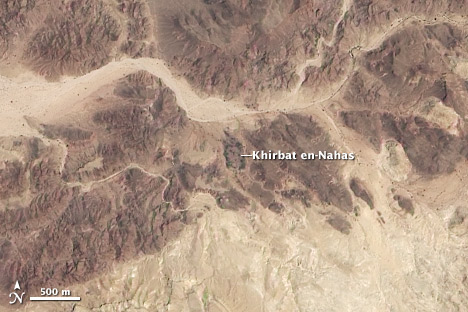
Dark gray piles of slag define ancient copper mining and smelting sites at Khirbat en-Nahas, in the desert between the Dead Sea and the Gulf of Aqaba. The square feature on the north side of the site is an Iron Age fortress. (NASA image by Robert Simmon, using Advanced Land Imager data.)
This type of user-driven experience was not part of the initial plans for EO-1, but it is an example of the spirit of exploration and experimentation that has characterized the mission.
Scheduled to fly for a year, designed to last a year and a half, EO-1 celebrates its tenth anniversary on November 21, 2010. During its decade in space, the satellite has accomplished far more than anyone dreamed.
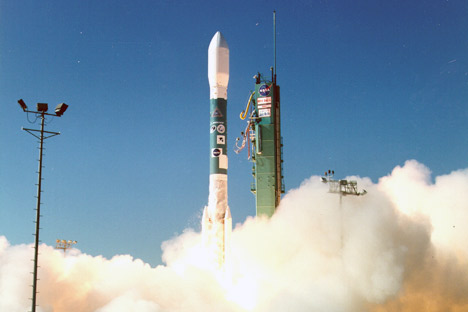
On November 21, 2000, the Earth Observing-1 satellite launched on a Delta II rocket from Vandenberg Air Force Base, California. (Photograph courtesy ATK.)
“Earth-Observing-1 has had three missions,” says mission manager Dan Mandl of NASA’s Goddard Space Flight Center (GSFC). Its original mission was to test new technologies, a mission completed in the first year. Its second mission was to provide images and data. Its third mission was to test new cost-saving software that operates the satellite semi-autonomously and allows users to target the sensors.
All of the missions come down to one thing: “We’re the satellite people can try things on.” Mandl calls EO-1 NASA’s on-orbit test bed, and the name rings true.
EO-1 was commissioned as part of NASA’s New Millennium Program, set up to develop and fly technology that would reduce the risk and cost of future science missions. In short, NASA told its engineers: find a way to fly faster, better, and cheaper.

The EO-1 satellite was assembled at NASA Goddard Space Flight Center. From left to right, the photos show the EO-1 satellite, the Advanced Land Imager, Hyperion, and the pulsed plasma thruster. (Photographs courtesy ATK and the NASA EO-1 team.)
“EO-1’s primary purpose was to demonstrate that the Advanced Land Imager (ALI) was a suitable follow-on instrument for Landsat,” says Bryant Cramer, the program manager at GSFC during EO-1’s development and launch. Like Landsat-7, ALI records seven wavelengths of light reflected from Earth’s surface. ALI also records an additional two wavelengths to improve measurements of forests and crops, coastal waters, and aerosols.
Later, an innovative new instrument, the Hyperion imaging spectrometer, was added to the mission. Hyperion records more than 200 adjacent wavelengths of light to even better understand the makeup of Earth’s surface.
“EO-1 succeeded beyond anyone’s expectations,” says former project scientist Steve Ungar (GSFC). He credits the mission’s success to EO-1’s “crackerjack team” of engineers and scientists, who were drawn to the mission because they recognized that they could have a stake in the future of satellite technology.
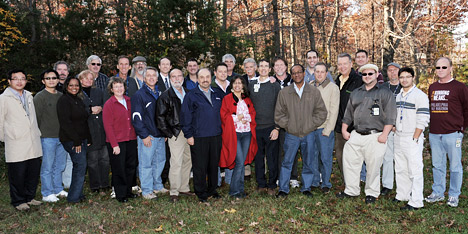
Some members of the EO-1 team gathered at NASA Goddard Space Flight Center on November 19, 2010. NASA Photograph by Deborah Mccallum.
In addition to the two primary sensors, the team proposed 32 new technologies for EO-1, including:
Though each new technology had the potential to advance spacecraft design, they also posed risks. The carbon-carbon radiators used for passive cooling, for example, were much lighter and simpler than traditional cryocoolers. “But when you touched the first carbon plates, your hand would come away black,” recalls Ungar.” Since this posed a risk to the imagers, the engineers had to come up with a coating to prevent contamination.”
“Hyperion is probably the future of remote sensing,” says Cramer. Hyperion is a hyperspectral instrument, a change in technology that is like going from black-and-white to color television, Mandl adds.
Other remote sensing instruments—multispectrometers—measure discreet wavelengths of light. It is as if your eyes could only see red and blue light; you could tell much about the world based on how much red and how much blue you saw, but your vision would have gaps in the green tones. A hyperspectral instrument corrects this color blindness by measuring many more wavelengths of light.

Multispectral sensors like ALI record discrete wavelengths of light, essentially sampling sections of the electromagnetic spectrum. A hyperspectral instrument like Hyperion records many adjacent wavelengths to image most of the spectrum within a set range. (NASA image by Robert Simmon.)
The science behind the hyperspectral instrument is spectroscopy, says current EO-1 project scientist, Elizabeth Middleton (GSFC). “Spectroscopy is the study of constituents of materials using specific wavelengths,” she notes. “Hyperion measures the chemical constituents of Earth’s surface.”
Chemists have long used spectroscopy to identify substances because everything reflects electromagnetic energy (including light) at specific wavelengths and in ways that are as unique as a fingerprint. By measuring the energy that comes from a material, scientists can figure out what the material is. Hyperion measures reflected light like many other satellite imagers, but since it is recording more than 200 wavelengths, it can detect the fingerprints of the materials on Earth’s surface.

Just as iron and copper look different in visible light, iron- and copper-rich minerals reflect varying amounts of light in the infrared spectrum. This graph compares the reflectance of hematite (an iron ore) with malachite and chrysocolla (copper-rich minerals) from 200 to 3,000 nanometers. (NASA image by Robert Simmon, using data from the USGS Spectroscopy Lab.)
Space-based imaging spectroscopy enables a wide range of science, including the search for those ancient copper mines and smelting sites in Jordan. “I’m looking for the spectrographic signature of copper-bearing minerals,” says Savage. He intended to use copper’s unique light signature to find more smelting sites near Khirbat en-Nahas, but as he started to work with Hyperion data, he realized that it could do much more.
“Hyperion has really opened up a whole new avenue of analysis that we hadn’t even explored before,” says Savage. “I can tell you where in the area the ore is coming from; which parts of the site were used for smelting and which were not; and that different parts of the site were drawing ore from different regions.” Such information would be prohibitively expensive to gather in field research, but Hyperion provides Levy (from the University of California-San Diego) with an affordable map that he can use to better target excavation at likely smelting sites and mines.


The hundreds of bands in hyperspectral imagery enable researchers to differentiate minerals and rocks that appear similar in visible light. Outcrops near Khirbat en-Nahas that are uniformly dark in natural color (top) are variegated in false-color (lower), signifying different rock types. (NASA images by Robert Simmon, using Hyperion data.)
Hyperion data have found a wide range of other uses, including tracking the amount of carbon plants take out of the atmosphere everywhere from the Amazon rainforest to the Alaskan tundra. It also has been used to find evidence of microbial life in the Arctic and to monitor volcanic activity.
Perhaps the most important thing Hyperion has done, says Middleton, is teach the community how to work with complex hyperspectral data. Germany will soon launch the next hyperspectral instrument, EnMap, followed by NASA’s HyspIRI satellite, which is still in the planning stage. Both missions build on lessons learned from Hyperion.
The Advanced Land Imager (ALI) was built, says Cramer, to test new technology and to provide a safe technology shift for future Landsat missions. The Landsat series of satellites has provided a continuous record of changes in Earth’s landscape from 1972 to the present. ALI images the Earth at the same level of detail (30 meters per pixel), and it has a more detailed set of sensors that enable crisp, photo-like images.
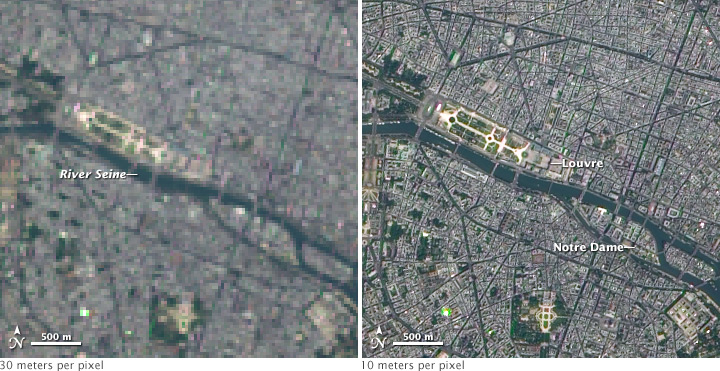
At ALI's resolution (30 meters per pixel), Paris is pixilated in this image from July 29, 2002. The image becomes sharp and clear when it parts data from ALI's more detailed sensors, the pan band, which see 10 meters per pixel in shades of gray.
ALI differs from previous Landsat sensors because of how it takes images. Previous Landsat instruments scanned from side to side, like a whiskbroom. The image is built from horizontal strips of information. ALI, on the other hand, is more like a push broom. It has detectors arranged parallel to one another and facing forward, and they collect information in vertical strips. This arrangement eliminates the need for the sensor optics to move from side to side, and fewer moving parts means less chance of failure, says EO-1 engineer Stuart Frye (GSFC).
A whiskbroom sensor, left, takes images by sweeping horizontally across the landscape as the satellite moves forward. A pushbroom sensor collects data in vertical strips as it moves forward.
After ten years of operation, ALI has proven that the push-broom technology is stable and reliable enough that the next Landsat satellite, the Landsat Data Continuity Mission, uses the same design. “The Landsat community is treating push-broom sensors like we’ve been building them for years,” says Cramer. “That’s a tribute to EO-1.”
The accumulation of small tweaks has had a large benefit for studying certain types of earthly events. “ALI is very useful in identifying smaller features such as floods and landslides on a local scale,” says Eric Anderson, a researcher at Cathalac, an organization that helps map disasters. Because ALI and Hyperion can be pointed at a particular location on the ground, scientists and disaster relief managers can gather images every 2-5 days; Landsat is usually limited to once in 16 days because it looks straight down.
As the EO-1 mission has aged, perhaps the most critical innovation has come from the onboard computer. “EO-1 has two separate computer processors with 256 megabytes of extra memory each,” says Mandl. That may seem paltry compared to a modern desktop computer, but it was enough to reshape a spacecraft’s mission. “It meant we had excess capacity to try new things.”
The first new software loaded onto EO-1 was the Autonomous Science Experiment, an onboard intelligent scheduling tool that allows the satellite to decide for itself which images Hyperion and ALI should take. Before the software, says Mandl, it took a flight engineer 67 steps to tell the satellite to acquire an image. “Now we send one command with a goal,” says Frye. “If the goal conflicts with another goal, the onboard scheduler decides which to image. Targeting is 100 percent automated.”
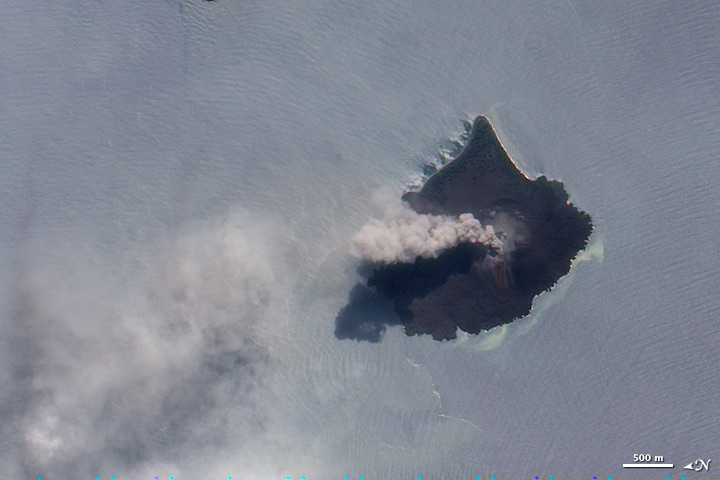
Indonesia’s Krakatau is one of the active volcanoes automatically monitored by SensorWeb. ALI took this image on November 17, 2010.
Because the satellite can think for itself, the system can accept a target request as late as five hours before the satellite flies over the target compared to 2-3 days required for most other sensors. The on-board scheduler prioritizes requests based on what they are for (ranked by theme) and the weather. The software uses predictions of cloudiness from the National Oceanic and Atmospheric Administration, so if a site is too cloudy, the next least-cloudy target will get priority.
“It’s a customer-driven method of running a mission,” says Mandl. Anyone from an archeologist to a disaster response agency can request images. “Flying a mission with a customizable user experience is one of EO-1’s greatest achievements.”
Sometimes the “customers” targeting EO-1 are other satellites. As part of SensorWeb, EO-1 automatically acquires images that are triggered by other satellites. For example, EO-1 monitors 100 volcanoes. When the Moderate Resolution Imaging Spectroradiometer (MODIS) on NASA’s Terra or Aqua satellites detects a hot spot at any of them, EO-1 automatically acquires an image on its next overpass. Hyperion can then record the temperature and position of lava flows, while ALI tracks ash plumes. If the onboard software detects a hot spot in the Hyperion measurement, the on-board systems automatically re-schedule another acquisition of that target at the next opportunity. The images are distributed to local officials. The SensorWeb system is a pathfinder to help build international satellite collaborations, particularly for disaster response.
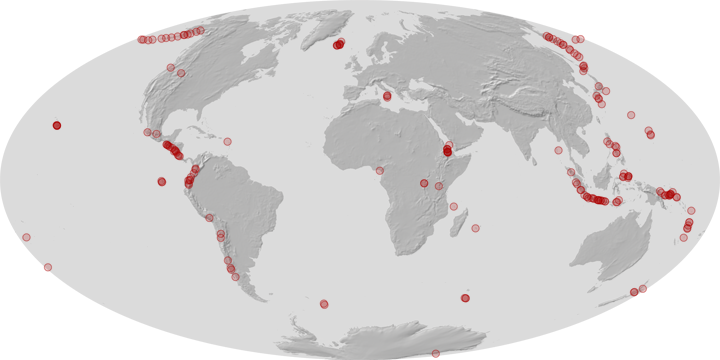
Red dots show the locations of the volcanoes that EO-1 monitors as part of the SensorWeb program. Activity at any of these volcanoes will automatically trigger EO-1’s sensors to collect images. (NASA map by Jesse Allen and Robert Simmon.)
SensorWeb and the scheduling tool have created significant cost savings. “Initially, we were spending about $7,500 per image to acquire them. Now the cost is less than $600 a scene,” says Cramer.
“EO-1 is one of the cheapest of NASA’s Earth missions,” confirms Middleton. These cost savings mean that anyone can now target EO-1 and access all data free of charge, making it useful to a growing range of people.
In the end, EO-1’s value far outweighs its price tag. “EO-1 has done so many different things, NASA got three or four missions for the price of one,” says Cramer. “We achieved all of the things that we hoped for and then some.”